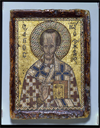Description
A single saint, shown frontally, half length, confronting the viewer with a steady gaze, against a golden background exemplifies, if not defines, a Byzantine icon. But, for the Byzantine worshiper, an icon could be any image (eikon= “image”) that was the focus of veneration. Thus, the dramatic rendering of the Forty Martyrs of Sebasteia (see BZ.1947.24) and the carved ivory panel with the Deposition of Christ from the Cross (see BZ.1952.12) are as fully icons as is this forceful portrait of the renowned Church Father, St. John Chrysostom.
St. John (340/50–407) was a native of Antioch in Syria, where he developed a reputation as a compelling preacher. He was invited to become bishop of Constantinople (398) but estranged himself from his wealthy auditors, especially members of the imperial court, by criticizing their luxurious way of life. He was banished (404) and died in exile. Nonetheless, his fame grew because of his eloquent writings. For centuries, the liturgy of the Orthodox Church was credited to him, although it no longer is.
The very ascetic face ensconced in the luxurious robes of a bishop against a shimmering gold background is attributed to a date of approximately 1325, during the early Palaiologan period (1261–1350), when the technique of miniature mosaic was developed to its highest degree. Because of the extremely small size of the tesserae, the image resembles a painting executed with brushstrokes of brilliant, reflective colors even when seen from a short distance. Unique among miniature mosaic icons, the halo of St. John has a curved surface, like many silver covers made to protect painted icons. The halo emphasizes the spiritual aspect of the saint’s head and the distinction of his verbal output, the reason he was called Chrysostomos or Golden Mouth, as inscribed on the icon.
- S. Zwirn
Bibliography
D. V. Ainalov, "Monuments Byzantins de l'Athos," Vizantiiskii Vremennik 6 (1899): 75-78, pl. 11.
N. P. Kondakov, Pamiatniki Khristianskago Iskusstva Na Afonie (Saint Petersburg, 1902), 116-117, pl. 16.
Badia greca di Grottaferrata di Maria Santissima, Esposizione italo-bizantina : Grottaferrata, 1905. (Rome, 1905), cat. no. 73, p. 34, 55.
A. Muñoz, L'art byzantin à l'exposition de Grottaferrata (Rome, 1906), 170, pl. 3.
O. K. Wulff and M. V. Alpatov, Denkmäler der Ikonenmalerei in Kunstgeschichtlicher Folge (Hellerau bei Dresden, 1925), 60-62, fig. 21.
The Dumbarton Oaks Collection, Harvard University (Washington, D.C., 1955), 147, 150, no. 291.
O. Demus, "Two Palaeologan Mosaic Icons in the Dumbarton Oaks Collection," Dumbarton Oaks Papers 14 (1960): 87-119.
A. V. Bank, "Mozaichnaiâ Ikona is b. sobranilâ N. P. Likhacheva," in Iz Istorii Russkogo i Zapadnoevropeiskogo Iskusstva: Materialy i Issledovaniia, ed. O.I. Podobedova and V.N. Grashchenkov (Moscow, 1960), esp. 192.
M. C. Ross, Metalwork, Ceramics, Glass, Glyptics, Painting, Catalogue of the Byzantine and Early Mediaeval Antiquities in the Dumbarton Oaks Collection 1 (Washington, D.C., 1962), 104, no. 125, pl. 61.
Byzantine Art, an European Art, exhibition catalogue, Zappeion Exhibition Hall, (Athens, 1964), 237, no. 169.
Handbook of the Byzantine Collection (Washington, D.C., 1967), 104, no. 353.
I. Furlan, Le Icone Bizantine a Mosaico (Milan, 1979), 91-92, pl. 37.
A.-A. Krickelberg-Pütz, "Die Mosaikikone des Hl. Nikolaus in Aachen-Burtscheid," Aachener Kunstblätter 50 (1982): 9-141, esp. 97, fig. 65.
C. Mango, "The Byzantine Collection," Apollo 119 (1984): 21-29, fig. 15.
"Icone," Le Grand atlas de l'archéologie, Encyclopædia Universalis (Paris, 1985) 879-86, 879-886, pl. 2.
L. Rodley, Byzantine Art and Architecture: An Introduction (Cambridge [England] ;New York, N.Y., 1994), 319-21, fig. 267.
Y. Piatnitsky, "The Portable Mosaic Icons from Vatopedi, Mount Athos," in Hiera Mone Vatopediou: Historia kai Techne 7, Athonika Symmeikta (Athens, 1999), 211-19, esp. 214-216, 219.
J. J. Allen, Vested in Grace: Priesthood and Marriage in the Christian East (Brookline, Mass., 2001).
H. C. Evans, Byzantium: Faith and Power (1261-1557), exhibition catalogue, Metropolitan Museum of Art, March 23-July 4, 2004, (New York and New Haven, Conn., 2004), 227-228, no. 135.
M. A. Fernández, Mosaics in Mexico: the Perdomo Family's Workshop, trans. M. Suderman, 1st ed. (Mexico City, 2006), fig. p. 26.
G. Bühl, ed., Dumbarton Oaks: The Collections (Washington, D.C., 2008), 180, pl. p. 181.
C. Antonova, Space, Time, and Presence in the Icon: Seeing the World with the Eyes of God, Ashgate Studies in Theology, Imagination, and the Arts (Farnham, Surrey, England; Burlington, VT, 2010), 41, fig. 2.4.
H. Maguire, Nectar and Illusion: Nature in Byzantine Art and Literature, Onassis Series in Hellenic Culture (New York, 2012), pl. XVIII.
T. Velmans, L'art de l'icône, Les Phares (Paris, 2013), 291.
Exhibition History
Grottaferrata, Badia Greca, "Esposizione Italo-bizantina," 1905.
Athens, Zappeion Exhibition Hall, "Byzantine Art, an European Art," Ninth Exhibition of the Council of Europe," April 1 - June 15, 1964.
Washington, DC, Dumbarton Oaks, "Masterpieces of Byzantine Icon Painting," April 27 - June 26, 1983.
New York, Metropolitan Museum of Art, "Byzantium: Faith and Power (1261-1557)," March 23 - July 4, 2004.
Washington, DC. Dumbarton Oaks, 75 Years/75 Objects: Celebrating 75 Years of the Dumbarton Oaks Museum, September 8, 2015 - May 22, 2016.



